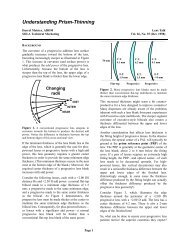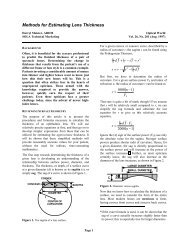Fundamentals of Progressive Lens Design - Laramy-K Optical
Fundamentals of Progressive Lens Design - Laramy-K Optical
Fundamentals of Progressive Lens Design - Laramy-K Optical
Create successful ePaper yourself
Turn your PDF publications into a flip-book with our unique Google optimized e-Paper software.
Critical Vision<br />
Critical vision generally involves sustained viewing tasks<br />
that require excellent visual acuity and a sufficiently wide<br />
field <strong>of</strong> clear vision. High visual acuity is only possible in the<br />
central viewing zones <strong>of</strong> a progressive lens. Since these<br />
zones are not well defined, their size and utility vary<br />
depending upon both the wearer's tolerance to blur and the<br />
nature <strong>of</strong> the viewing task.<br />
The size <strong>of</strong> the central viewing zones can be increased by<br />
pushing the surface astigmatism <strong>of</strong> the lens design farther<br />
into the periphery. However, this trade-<strong>of</strong>f results in higher<br />
and more rapidly increasing levels <strong>of</strong> unwanted cylinder<br />
power. Therefore, the size <strong>of</strong> the distance and near viewing<br />
zones should be no larger than necessary in order to avoid<br />
unnecessary compromises in optical performance. Further,<br />
the lens designer must determine the best visual balance<br />
between the relative sizes <strong>of</strong> these two viewing zones<br />
(Figure 8).<br />
Dynamic Vision<br />
The blur produced by the unwanted cylinder power in the<br />
periphery <strong>of</strong> a progressive lens is less consequential to<br />
dynamic vision, which <strong>of</strong>ten requires only recognizing and<br />
localizing objects. However, the progressively changing<br />
Add power and unwanted cylinder power in the periphery<br />
may also produce rapid variations in prism and<br />
magnification. These variations can produce an optical<br />
effect known as image swim in which objects appear to<br />
shift, distort, or even sway unnaturally.<br />
The vestibular apparatus, which is an organ within the inner<br />
ear linked to the visual system, helps to maintain your<br />
sense <strong>of</strong> balance and to stabilize vision while in motion. An<br />
annoying visual phenomenon may arise when the apparent<br />
movement <strong>of</strong> the visual environment through the lens<br />
differs from the physical movement or orientation detected<br />
by the wearer because <strong>of</strong> image swim. This vestibuloocular<br />
conflict may produce an unpleasant “rocking”<br />
sensation similar to vertigo or motion sickness.<br />
Objects—such as straight lines—may also appear curved<br />
or skewed when viewed through the lateral areas <strong>of</strong> the<br />
lens. Since the unwanted cylinder power in the periphery <strong>of</strong><br />
the lens is generally oriented at an oblique axis, unequal<br />
magnification occurs in oblique directions. This oblique<br />
magnification, which is referred to as skew distortion,<br />
causes the vertical and horizontal edges <strong>of</strong> images to tilt<br />
and stretch (Figure 9).<br />
Figure 8. The lens designer must find the optimum balance<br />
between the size <strong>of</strong> the distance and near zones in a<br />
progressive lens.<br />
The configuration <strong>of</strong> the central viewing zones should be<br />
consistent with the typical wearer’s physiological interaction<br />
with the environment, including the viewing tasks the<br />
wearer is likely to perform throughout the day. This requires<br />
careful consideration <strong>of</strong> the range and nature <strong>of</strong> typical<br />
viewing tasks, as well as the relative frequency <strong>of</strong> those<br />
tasks. There are also progressive lenses available that<br />
have been designed for specific viewing tasks, such as<br />
computer use.<br />
Additionally, the object geometry <strong>of</strong> those viewing tasks is<br />
equally important. The distribution <strong>of</strong> the surface optics and<br />
Add power <strong>of</strong> the lens design should correspond to the<br />
typical size, position, and orientation <strong>of</strong> the objects involved<br />
in these viewing tasks. For instance, the optics <strong>of</strong> the<br />
central viewing zones should be refined in order to ensure<br />
that the correct Add power is available to the wearer for the<br />
typical reading distance associated with each viewing task.<br />
Figure 9. The magnification produced by the obliquely<br />
oriented cylinder power in the peripheral regions <strong>of</strong> a<br />
progressive lens results in an apparent shearing <strong>of</strong> objects<br />
and other potentially disturbing visual effects.<br />
The distribution <strong>of</strong> surface optics in the periphery <strong>of</strong> a<br />
progressive lens should be carefully managed in order to<br />
minimize image swim, skew distortion, and other unwanted<br />
optical “side-effects.” Image swim, which can result in the<br />
apparent acceleration <strong>of</strong> images, can be minimized by<br />
controlling the rates <strong>of</strong> change in prism and power. Skew<br />
distortion can be minimized by controlling the axis <strong>of</strong> the<br />
unwanted astigmatism in the periphery so that it is<br />
generally oriented at a less oblique angle.<br />
Page 4









